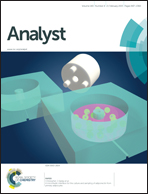Comparison of the different responses of surface plasmon resonance and quartz crystal microbalance techniques at solid–liquid interfaces under various experimental conditions†
Abstract
A molecular level understanding of the phenomena taking place at solid–liquid interfaces, ranging from changes in mass to conformation changes, is the key to developing and improving many chemical and biological systems and their scientific and medical applications. Surface plasmon resonance (SPR) and quartz crystal microbalance (QCM) techniques are often coupled to achieve this understanding. We divided various experimentally relevant scenarios into the following six categories: boundary solutions; surface modifications; conformation; viscoelastic properties; molecular ruler; and mass sensitivity. For each case, based on theoretical analyses, we discuss the following four points with respect to discrete adsorbates at solid–liquid interfaces: (1) the different types of information that can be obtained, why it can be obtained and how to obtain it; (2) the origins of many current approaches and why they are imperfect; (3) guidelines for experimental design; and (4) possible studies, such as the effect of dimensional confinement and adsorption forces on the ability of conformational changes to occur on the receipt of external stimuli and the hysteresis in these changes.


 Please wait while we load your content...
Please wait while we load your content...